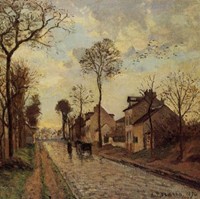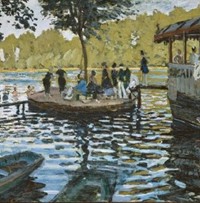|
|
In rendering this homage to him Cezanne
was most likely thinking of the months in 1872 and 1873 when he worked
at Pontoise under the direction of his friend, alongside whom he had in
a way gone back to school. From this working retreat his art emerges transformed.
For a long time Pissarro has recognised the immense gifts of Cezanne.
The confidence he shows in him encourages the touchy man from Aix to forget
his dramatic, gloomy manner, his allegoric and literary leanings, and
to give himself over to pure painting. Very humbly, Cezanne begins by
putting a canvas by Pissarro in front of him and making a very close copy
of it. This allows him to become familiar with the new technique of colour
laid on with small strokes of the brush, in patches, but also to go deeply
into the secret of relief. He finds that tension can be expressed without
recourse to vehemence. His character, more inclined towards meditation
than invention, finds an inexhaustible peace and a starting-point in the
contemplation of nature. This long association, which lasted almost two
years, was a most rewarding one for the two friends. Each had a profound
influence on the other, which both were happy to recognise. In recalling
this, several historians are not afraid to use the term "mutation"
for the works of the Aix painter. Cezanne, conscious of his debt to Pissarro,
even says, "Perhaps we are all products of Pissarro." The latter,
for his part, acquires from his companion a sense of the monumental.
Cezanne puts the experience he has gained to good use at Auvers-sur-Oise,
where he has come to stay at the end of 1873 with Dr Gachet (later to
be immortalized in portraits by Van
Gogh). As evidenced by "Maison du Docteur Gachet" and above
all the famous "Alaison du Pendu," at Auvers-sur-Oise, the atmosphere
of Auvers, which at the time was a small rustic village, the friendliness
and courtesy of his host who was also his confidant and his first collector,
allowed him to apply himself arduously to his work. Before nature he abandons
his live treatment, heavy and often opaque, seeks a scrupulous fidelity
in observation and gets down to translation of all shades of colour. His
soul is more easy and he finds a more even form of working; his colour
is lightened and his brushwork is very definite and spaced out with regularity.
However, he often has to go over his work again and his canvases are covered
in successive layers. This effort in execution sometimes makes the work
a little heavy but never alters the new rhythm of his composition. His
paint assumes a gritty look but his palette is definitely lightened. From
then onwards he is able to commence his fabulous attempt to reconstruct
the world.
Degas: Systematic Study
At this time each of the painters has found
his way. Edgar Degas, after
a voyage to New Orleans which shows him receptive to the exotic charm
of colonial life, becomes definitely taken by the mechanisms of daily
life and begins a systematic study of them. It is the world of dancing,
observed in the wings of the Opera, that of laundresses or that of the
racecourse that attracts all his attention.
In spite of his strange personality, his particularism, Degas must not
be separated from his friends as one is often tempted to do. His methods
are different; he is wary of the open air and insists on the rights of
imagination, but it is to make a better repertoire of the features of
the subject and preserve them from all apparent alteration. He is shown
in reality as a faithful observer, even a maniac for reality; he gives
it only such embellishment as his vision dictates. His eye is sharp and
his memory so well exercised that he succeeds in reproducing the subject
in its full tension and accompanied by an atmosphere and light prodigiously
shaded with colour. Even if he works in the studio from drawings and sketches
with very detailed written notes, it is perhaps this which gives better
the impression that he has captured life throbbing in most delicate fluidity.
He makes use of the violent direct lighting of a stage, but most often
in contrast with shadows, demi-tints and indefinite lighting, with the
sole object of creating ranges of very diverse intensity.
Painter of the stage, of shows brilliant under the footlights, he prefers
exercises, rehearsals, the rooms in which the significance of an art is
spelled out in daily work. His figures, never static, are caught in their
most mobile aspect, or better still in the preparation for or suspended
in a gesture, like the dancer listening for her cue, the horse gathering
its strength before the start of the race. Various techniques of setting
and layout borrowed from the Far East, the overhead view, the diagonal,
give Degas the means of making striking variations of the same subject.
But in pursuing magnification, in giving values to curious or interesting
detail which in its turn becomes a microcosm, a condensation of feelings,
he arrives at a sort of depersonalisation of the subject who gradually
is abolished, reduced to his or her basic functions and characteristic
attitudes.
His technique is no less remarkable. Colours
dissolve into luminous powdery clouds and space between figures assumes
an indefinable liveliness. He begins by using pastels which, mixed in
gouache and moistened with steam
from boiling water and placed and fixed layer after layer, gives him a
material of dazzling, pearly richness.
The Goncourts, visiting his studio in 1874, described Degas as sickly
and neurotic and saw nothing in his research except the result of troubles
which he was beginning to have with his eyes, (in the same way as some
tried to explain the deformation of shape practised by El Greco). In reality
Degas had an anxious and impassioned mind, never satisfied with the outcome
of his work and carrying out well-reasoned and very learned experiments.
He worked out a veritable chemistry of colours. A fierce hater of mankind,
he applied himself with the detachment of an entymologist to studying
the human machine dismantled into its basic or most intimate parts. In
one field and another after 1872 his work produced some capital discoveries.
For more, see: Best
Impressionist Paintings.
NEXT: (8) Impressionist
Exhibitions in Paris.
Acknowledgements:
We gratefully acknowledge the use of an excerpt from Impressionism,
by Jacques Lassaigne (1966).
|


